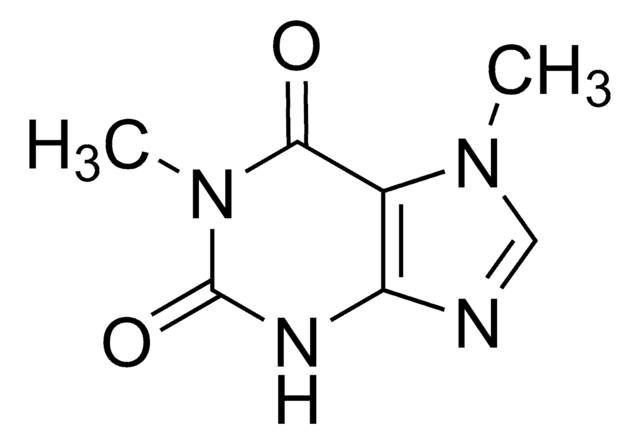D5385
1,7-Dimethylxanthine
~98% (TLC), solid, adenosine receptor ligand
Sinónimos:
1,7-Dimethyl-1H-purine-2,6-dione, 1,7-Dimethyl-3,7-dihydro-1H-purine-2,6-dione, 2,6-Dihydroxy-1,7-dimethylpurine, NSC 400018, Paraxanthine
About This Item
Productos recomendados
Nombre del producto
1,7-Dimethylxanthine, ~98%, solid
Ensayo
~98%
Nivel de calidad
Formulario
solid
color
white
mp
294-296 °C (lit.)
solubilidad
ethanol: 0.6 mg/mL
H2O: 1 mg/mL
0.1 M NaOH: 2 mg/mL
cadena SMILES
CN1C(=O)Nc2ncn(C)c2C1=O
InChI
1S/C7H8N4O2/c1-10-3-8-5-4(10)6(12)11(2)7(13)9-5/h3H,1-2H3,(H,9,13)
Clave InChI
QUNWUDVFRNGTCO-UHFFFAOYSA-N
Información sobre el gen
human ... ADORA1(134) , ADORA2A(135) , ADORA2B(136) , ADORA3(140)
rat ... Adora1(29290) , Adora2a(25369)
¿Está buscando productos similares? Visita Guía de comparación de productos
Descripción general
Aplicación
Acciones bioquímicas o fisiológicas
Características y beneficios
Palabra de señalización
Warning
Frases de peligro
Consejos de prudencia
Clasificaciones de peligro
Acute Tox. 4 Oral
Código de clase de almacenamiento
11 - Combustible Solids
Clase de riesgo para el agua (WGK)
WGK 1
Punto de inflamabilidad (°F)
Not applicable
Punto de inflamabilidad (°C)
Not applicable
Equipo de protección personal
dust mask type N95 (US), Eyeshields, Gloves
Elija entre una de las versiones más recientes:
Certificados de análisis (COA)
¿No ve la versión correcta?
Si necesita una versión concreta, puede buscar un certificado específico por el número de lote.
¿Ya tiene este producto?
Encuentre la documentación para los productos que ha comprado recientemente en la Biblioteca de documentos.
Los clientes también vieron
Artículos
Cyclic nucleotides like cAMP modulate cell function via PKA activation and ion channels.
Cyclic nucleotides like cAMP modulate cell function via PKA activation and ion channels.
Cyclic nucleotides like cAMP modulate cell function via PKA activation and ion channels.
Cyclic nucleotides like cAMP modulate cell function via PKA activation and ion channels.
Nuestro equipo de científicos tiene experiencia en todas las áreas de investigación: Ciencias de la vida, Ciencia de los materiales, Síntesis química, Cromatografía, Analítica y muchas otras.
Póngase en contacto con el Servicio técnico








